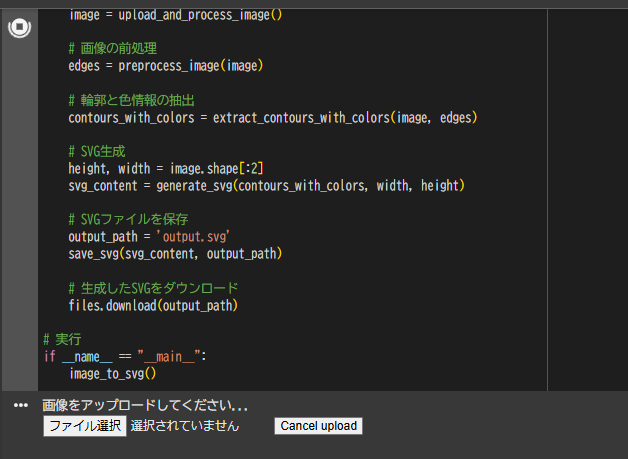はじめに
この記事では、Google Colaboratoryを使用して画像ファイルからSVGを生成する方法を説明します。PythonのOpenCVとnumpyのみを使用して実装します。
概要
- 画像の前処理(グレースケール化、エッジ検出)
- 輪郭抽出
- SVGパスの生成
- SVGファイルの出力
実装コード
import cv2
import numpy as np
from google.colab import files
from pathlib import Path
import base64
def upload_and_process_image():
"""Google Colabで画像をアップロードして処理する"""
uploaded = files.upload()
file_name = next(iter(uploaded))
return cv2.imdecode(np.frombuffer(uploaded[file_name], np.uint8), cv2.IMREAD_COLOR)
def preprocess_image(image):
"""画像の前処理を行う"""
# グレースケール変換
gray = cv2.cvtColor(image, cv2.COLOR_BGR2GRAY)
# ノイズ除去
blurred = cv2.GaussianBlur(gray, (5, 5), 0)
# エッジ検出
edges = cv2.Canny(blurred, 50, 150)
return edges
def extract_contours_with_colors(image, edges):
"""エッジから輪郭を抽出し、色情報も取得する"""
contours, _ = cv2.findContours(edges, cv2.RETR_EXTERNAL, cv2.CHAIN_APPROX_SIMPLE)
# 小さすぎる輪郭を除外
min_contour_length = 10
contours = [cnt for cnt in contours if len(cnt) >= min_contour_length]
# 各輪郭の代表色を取得
contours_with_colors = []
for contour in contours:
# マスクを作成
mask = np.zeros(image.shape[:2], dtype=np.uint8)
cv2.drawContours(mask, [contour], -1, 255, -1)
# マスク領域の平均色を計算
mean_color = cv2.mean(image, mask=mask)[:3]
contours_with_colors.append({
'contour': contour,
'color': mean_color
})
return contours_with_colors
def contour_to_path(contour):
"""輪郭データをSVGパスに変換する"""
if len(contour) < 2:
return ""
path = f"M {contour[0][0][0]},{contour[0][0][1]}"
for point in contour[1:]:
path += f" L {point[0][0]},{point[0][1]}"
path += " Z"
return path
def generate_svg(contours_with_colors, width, height):
"""SVGファイルを生成する(色情報付き)"""
svg = f'<svg xmlns="http://www.w3.org/2000/svg" width="{width}" height="{height}">\n'
for item in contours_with_colors:
contour = item['contour']
color = item['color']
# RGB値を16進数に変換
color_hex = '#{:02x}{:02x}{:02x}'.format(
int(color[2]), # OpenCVはBGR順なのでインデックスを調整
int(color[1]),
int(color[0])
)
path = contour_to_path(contour)
if path:
# 輪郭を塗りつぶしとストロークの両方で表現
svg += f' <path d="{path}" fill="{color_hex}" stroke="{color_hex}" stroke-width="1" opacity="0.8"/>\n'
svg += '</svg>'
return svg
def save_svg(svg_content, output_path):
"""SVGファイルを保存する"""
with open(output_path, 'w', encoding='utf-8') as f:
f.write(svg_content)
def image_to_svg():
"""メイン処理(色情報付き)"""
# 画像をアップロード
print("画像をアップロードしてください...")
image = upload_and_process_image()
# 画像の前処理
edges = preprocess_image(image)
# 輪郭と色情報の抽出
contours_with_colors = extract_contours_with_colors(image, edges)
# SVG生成
height, width = image.shape[:2]
svg_content = generate_svg(contours_with_colors, width, height)
# SVGファイルを保存
output_path = 'output.svg'
save_svg(svg_content, output_path)
# 生成したSVGをダウンロード
files.download(output_path)
# 実行
if __name__ == "__main__":
image_to_svg()
使用方法
- Google Colabで新しいノートブックを作成します。
- 上記のコードをセルにコピー&ペーストします。
- セルを実行すると、画像のアップロード画面が表示されます。
- 変換したい画像を選択してアップロードします。
- 処理が完了すると、自動的にSVGファイルがダウンロードされます。
処理の詳細説明
1. 画像の前処理
- ガウシアンブラーでノイズを除去
- Cannyエッジ検出で輪郭を抽出
- 元画像の色情報を保持
2. 輪郭と色情報の抽出
-
cv2.findContoursで輪郭点列を取得 - 小さすぎる輪郭を除外してノイズを削減
- 各輪郭領域の平均色を計算
- マスクを使用して正確な領域の色を抽出
3. SVGパスの生成
- 輪郭点列をSVGのパスコマンドに変換
- Mコマンドで開始点を指定
- Lコマンドで直線を描画
- Zコマンドでパスを閉じる
4. SVGファイルの出力
- SVGヘッダーとスタイルを設定
- パスデータを追加
- ファイルとして保存
カスタマイズのポイント
- エッジ検出の閾値調整
edges = cv2.Canny(blurred, 50, 150) # 閾値を調整して検出感度を変更
- 輪郭の最小サイズ変更
min_contour_length = 10 # 値を変更して細かい輪郭の除外基準を調整
- 色の透明度調整
# SVGのopacity値を変更して透明度を調整
svg += f' <path d="{path}" fill="{color_hex}" stroke="{color_hex}" stroke-width="1" opacity="0.8"/>\n'
- 色の抽出方法のカスタマイズ
# 平均色の計算方法を変更(例:メディアン値を使用)
median_color = cv2.medianBlur(masked_image, ksize=5)
注意点
- 複雑な画像の場合、処理に時間がかかる可能性があります。期待するような抽出ができなことがあります。
- 画像のサイズが大きい場合は、事前にリサイズすることをお勧めします
- エッジ検出の閾値は画像によって調整が必要な場合があります
まとめ
このコードを使用することで、Google Colab上で簡単に画像からSVGを生成することができます。外部ライブラリに依存せず、基本的なPythonライブラリのみを使用しているため、環境構築も容易です。
画像の種類や目的に応じて、パラメータを調整することで、より良い結果を得ることができます。
参考資料
- OpenCV公式ドキュメント: https://docs.opencv.org/
- SVG仕様: https://www.w3.org/TR/SVG2/
- Google Colab ドキュメント: https://colab.research.google.com/




